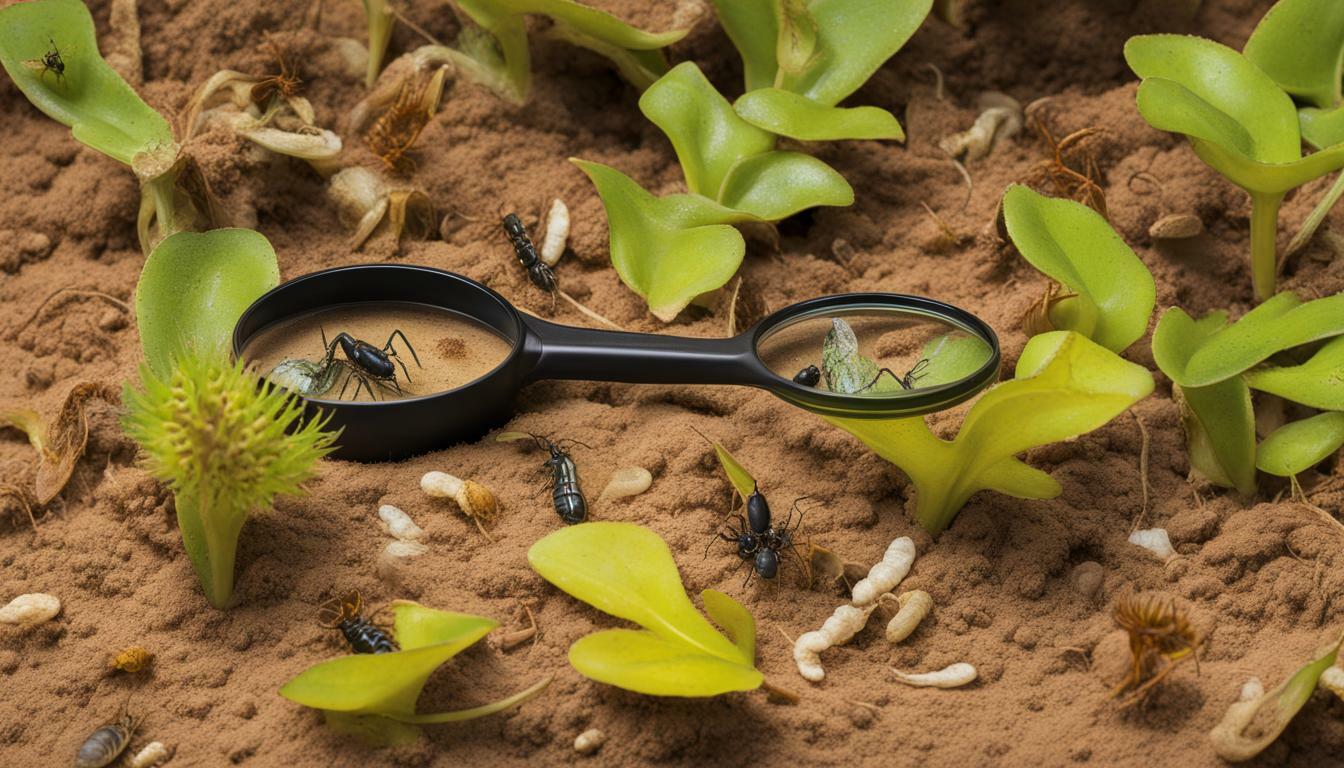If you’re someone who loves to take care of plants, you’ve probably heard of Venus Flytraps. These unique plants are a carnivorous species that can capture and digest insects for nutrition. However, just like any other plant, Venus Flytraps can also fall ill to various diseases.
It’s essential to know the common diseases that affect Venus Flytraps so that you can identify and treat them promptly. In this article, we’ll discuss the common diseases that affect Venus Flytraps and provide tips on how to prevent and treat them.
Key Takeaways:
- Venus Flytraps are carnivorous plants that can capture and digest insects for nutrition.
- Just like any other plant, Venus Flytraps can also fall ill to various diseases.
- It’s essential to know the common diseases that affect Venus Flytraps so that you can identify and treat them promptly.
Identifying Common Diseases in Venus Flytraps
If you’re determined to become a Venus flytrap owner, it’s crucial to be knowledgeable about the common diseases that can affect your plant. Some of the most prevalent health issues that your Venus flytrap may encounter include fungal diseases, bacterial infections, and viral diseases. Ignoring these ailments can lead to the death of your beloved plant, so it’s crucial to learn how to identify the symptoms of these diseases and take corrective measures promptly.
1. Fungal Diseases in Venus Flytraps
One of the most common ailments that Venus flytraps face are fungal diseases. The most common types of fungus that attack Venus Flytraps are Rhizoctonia and Pythium. The first symptoms of a fungal infection include browning of leaves, root rotting, and a softening of the plant. To treat Venus flytrap fungal diseases, you need to remove the infected parts of the plant, and use a fungicide to eliminate the remaining fungus. Proper ventilation and reducing humidity levels are essential to prevent fungal growth in Venus flytraps.
2. Bacterial Infections in Venus Flytraps
Another common ailment in Venus flytraps is bacterial infections, which can cause blackening and rotting of the leaves. Bacterial infections are caused by Pseudomonas bacteria and are highly contagious between plants. Early symptoms of bacterial infections include a softening of the plant and blackening of the leaves. To treat bacterial infections, remove the infected parts of the plant, apply a copper fungicide, and lower the humidity levels. Infected plants are best isolated from healthy ones to prevent the spread of the disease.
3. Viral Diseases in Venus Flytraps
Viral diseases are rarer than bacterial or fungal diseases, but they can still occur in Venus flytraps. These types of diseases are difficult to identify due to their subtlety, but mosaic patterns on the leaves are a sign of concern. If an infected plant is identified, it must be discarded immediately to prevent the spread of the virus to other plants. There is no cure for viral diseases, and prevention is the only way to avoid them. Good hygiene practices and preventing cross-contamination between plants can be helpful.
Being aware of the common health issues that Venus flytraps face is crucial to sustaining a healthy plant. Knowing what to look out for and how to treat these diseases will prevent your plant from dying prematurely. Regular maintenance, proper ventilation, and reduced humidity levels can help keep your Venus flytrap healthy and free from diseases.
Fungal Diseases in Venus Flytraps
Venus flytraps are susceptible to various fungal diseases, which can ultimately lead to the plant’s death if left untreated.
The most common fungal disease affecting Venus flytraps is Botrytis cinerea, also known as gray mold. This fungus attacks the plant’s tissues, causing them to rot and turn brown. It is a highly contagious disease and can spread quickly throughout the plant if not treated promptly.
| Fungal Disease | Symptoms |
|---|---|
| Botrytis cinerea | Brown and rotting tissue |
| Phytophthora | Yellowing leaves and soft, blackened stems |
| Rhizoctonia | Brown spots on the leaves |
Phytophthora is another type of fungal disease that affects Venus flytraps. It typically attacks the roots of the plant, causing them to rot and decay. This disease can be identified by the yellowing of leaves and soft, blackened stems.
Lastly, Rhizoctonia is yet another fungal disease that affects Venus flytraps. This disease appears as brown spots on the leaves and can eventually lead to the plant’s death if left untreated.
To prevent fungal diseases, make sure to keep your Venus flytrap’s soil well-drained, and avoid overwatering. Additionally, make sure to keep the plant in a well-ventilated area with adequate sunlight, as this will reduce the chances of fungal growth.
Bacterial Infections in Venus Flytraps
Venus flytraps are unique plants that are known for their carnivorous tendencies. However, even though Venus flytraps have a remarkable ability to capture and digest prey, they are not immune to diseases and infections.
One of the most common ailments that affect Venus flytraps is bacterial infections. Bacterial infections can occur when the plant is exposed to bacteria when an insect is captured or through other environmental factors.
The symptoms of bacterial infections in Venus flytraps often include yellowing and wilting of leaves, as well as the appearance of black spots on the leaves. In severe cases, the entire plant can become mushy and start to rot.
If you suspect that your Venus flytrap has a bacterial infection, the first step is to remove any infected leaves or other parts of the plant. Once you have removed the infected parts, you can apply a fungicide or bactericide to the remaining healthy parts of the plant to prevent further infection.
To prevent bacterial infections in your Venus flytrap, it is essential to keep the plant healthy and stress-free. Avoid overwatering or underwatering the plant, and ensure that it receives enough sunlight and nutrients.
If your Venus flytrap continues to develop bacterial infections despite your best efforts, it may be necessary to seek the help of a professional gardener or plant specialist. These experts can help you identify the underlying cause of the infections and provide you with the necessary tools and resources to keep your Venus flytrap healthy and happy.
Viral Diseases in Venus Flytraps
Venus flytraps are susceptible to viral diseases that can weaken or kill the plant if left untreated. Unfortunately, there is no cure for viral infections, so prevention is key.
The most common viral disease in Venus flytraps is the tomato spotted wilt virus, which causes yellowing and brown streaking on the leaves. The virus is spread by thrips, tiny insects that feed on plants. Infected plants should be removed and destroyed to prevent the spread of the virus.
The cucumber mosaic virus can also infect Venus flytraps, causing mosaic patterns on the leaves and stunted growth. The virus is spread by aphids, so it’s important to control aphid populations in your garden.
Preventing Viral Infections
To minimize the risk of viral infections in your Venus flytraps, it’s important to maintain good plant hygiene. Always sanitize your gardening tools between plants, and avoid working with your plants when they are wet, as this can spread disease.
In addition, quarantine any new plants for several weeks before introducing them to your garden, as they may be carrying viruses or other diseases that could infect your existing plants.
By taking these precautions, you can help keep your Venus flytraps healthy and free from viral infections.
Conclusion
In conclusion, Venus Flytraps can suffer from a variety of diseases caused by fungi, bacteria, and viruses. Understanding the common diseases that affect Venus Flytraps is crucial to keeping them healthy and thriving. By knowing the signs and symptoms of these diseases and taking prompt action, you can minimize the damage and prevent the spread of the diseases. Regularly inspecting your Venus Flytraps and maintaining proper growing conditions such as adequate sunlight and water can also help prevent diseases. Remember to always use sterile instruments and avoid over-fertilizing your Venus Flytraps to keep them healthy. With proper care and attention, your Venus Flytraps will continue to fascinate and delight you for years to come.Can the Color of a Venus Flytrap be affected by Common Diseases?
The color of a Venus Flytrap can indeed be affected by common diseases, leading to changes in the plant’s overall health. When afflicted, the venus flytrap’s color and its health can deteriorate, impacting its ability to catch insects for nutrition. Monitoring and addressing any diseases promptly is crucial to ensure the flytrap remains vibrant and functional.
FAQ
Q: What are the common diseases that affect Venus Flytraps?
A: Common diseases that affect Venus Flytraps include fungal diseases, bacterial infections, and viral diseases.
Q: How can I identify common diseases in Venus Flytraps?
A: Common diseases in Venus Flytraps can be identified by observing symptoms such as discoloration, wilting, rotting, or unusual growth patterns.
Q: What are some examples of fungal diseases in Venus Flytraps?
A: Examples of fungal diseases in Venus Flytraps include leaf spot, root rot, and powdery mildew.
Q: How can I treat fungal diseases in Venus Flytraps?
A: Fungal diseases in Venus Flytraps can be treated by improving air circulation, reducing humidity, and using fungicides specifically formulated for carnivorous plants.
Q: What are bacterial infections in Venus Flytraps?
A: Bacterial infections in Venus Flytraps are caused by bacteria entering the plant’s tissues and can lead to rotting, blackening, or necrosis.
Q: How can I prevent bacterial infections in Venus Flytraps?
A: To prevent bacterial infections in Venus Flytraps, it is important to maintain proper hygiene, avoid overwatering, and ensure the plant has good drainage.
Q: Are there viral diseases that affect Venus Flytraps?
A: Yes, there are viral diseases that can affect Venus Flytraps, although they are less common compared to fungal and bacterial diseases.
Q: How do viral diseases in Venus Flytraps spread?
A: Viral diseases in Venus Flytraps can spread through infected tools, insects, or contaminated soil.
Q: Can viral diseases in Venus Flytraps be cured?
A: There is no cure for viral diseases in Venus Flytraps. Infected plants should be isolated and removed to prevent further spread.











